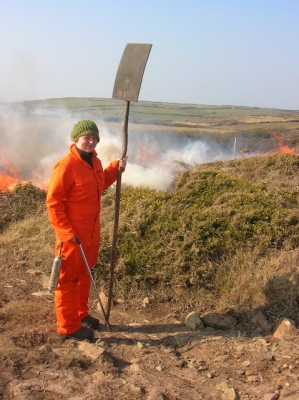 Those of you who are regular watchers of the sky may have noticed in the last few weeks that it changed from its more traditional winter colour of battleship grey to something approaching a pleasing shade of blue. Yet, at this time of year, cometh the blue sky, cometh the smoke as farmers and conservationists alike took the opportunity of this window of dry and settled weather to burn selected patches of heathland. For those unfamiliar with the practice it appears a destructive form of habitat management, but carried out correctly it has a number of benefits for both graziers and wildlife and is regarded as one of man’s oldest land management tools, predating civilisation itself.
Those of you who are regular watchers of the sky may have noticed in the last few weeks that it changed from its more traditional winter colour of battleship grey to something approaching a pleasing shade of blue. Yet, at this time of year, cometh the blue sky, cometh the smoke as farmers and conservationists alike took the opportunity of this window of dry and settled weather to burn selected patches of heathland. For those unfamiliar with the practice it appears a destructive form of habitat management, but carried out correctly it has a number of benefits for both graziers and wildlife and is regarded as one of man’s oldest land management tools, predating civilisation itself.
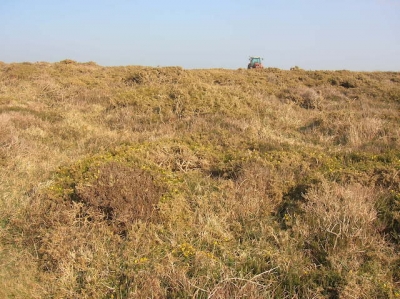 Heathland areas can be home to a broad and surprising amount of flora and fauna, but left unmanaged it will slowly become dominated by species such as gorse, heathers and some of the more vigorous grasses and the overall number of species present will decline. Ideally an area of heathland should be a mosaic made up of the key species at all stages of development, with life flourishing in the spaces in between. The result of a winter burn is to effectively wipe the slate clean for an area, with the dead and woody material going up in smoke and the heathers, gorses and grasses pruned back to ground level – the rootstocks protected from damage by the cold and wet ground. As light and warmth penetrates the newly revealed bare ground, long dormant seeds spring to life and a whole new cycle of flowering and seeding begins anew. At this juncture it is worth pointing out that a summer fire would do none of this and instead destroy rootstocks, seed banks and slow moving fauna, changing the composition of an area for many, many years to come.
Heathland areas can be home to a broad and surprising amount of flora and fauna, but left unmanaged it will slowly become dominated by species such as gorse, heathers and some of the more vigorous grasses and the overall number of species present will decline. Ideally an area of heathland should be a mosaic made up of the key species at all stages of development, with life flourishing in the spaces in between. The result of a winter burn is to effectively wipe the slate clean for an area, with the dead and woody material going up in smoke and the heathers, gorses and grasses pruned back to ground level – the rootstocks protected from damage by the cold and wet ground. As light and warmth penetrates the newly revealed bare ground, long dormant seeds spring to life and a whole new cycle of flowering and seeding begins anew. At this juncture it is worth pointing out that a summer fire would do none of this and instead destroy rootstocks, seed banks and slow moving fauna, changing the composition of an area for many, many years to come.
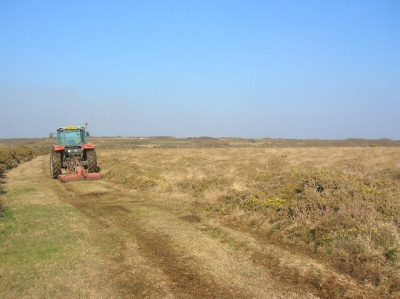
Being a potentially hazardous activity, heathland burning comes with a code of practice, namely the ‘Heather and Grass Burning Regulations 1986’ which lays out times, methods and best practice for carrying out burning. Though the season lasts from the start of October to the end of March, burning on the Lizard has traditionally taken place during the months of February and March. By then the vegetation has thoroughly died back and usually the worst of the winter weather has passed, though life remains dormant. Burning at this time ensured that the potash produced from the burning vegetation remained present to give a boost to the fresh vegetation, rather than being washed through the soil by the winter rains. For many centuries farmers burned areas of heathland to improve its potential for their livestock when they were grazing this marginal land without giving any great thought to the benefits it conferred to other species. Yet that link remains and whilst we burn to improve conditions for a variety of species, if that burning is not followed up with grazing the overall benefits can be much diminished.
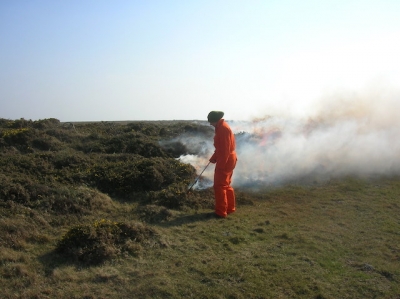 |
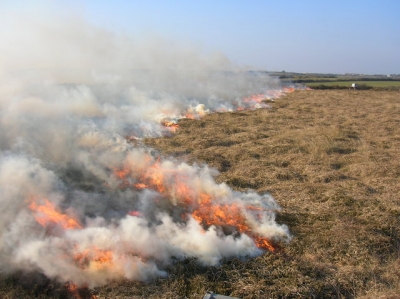 |
| Claire sets the fire front in motion | The fire front at full extent |
As nature reserve staff we endeavour to carry this task out to the highest standard and this requires a degree of prior preparation. Sites to be burned have been identified for their botanical and grazing potential, firebreaks have been prepared in advance and only when the fire brigade have been informed and the conditions are right are the torches applied. Having determined that the smoke produced will not be drifting across a busy road or unduly effecting a near neighbour, we light up a point on the firebreak furthest from the prevailing wind that day. This ensures that throughout the burn the fire front is travelling into the wind, which acts as a brake on the speed of travel of the flames. Because it is travelling slowly the fire front is more controlled, burns the vegetation more effectively and allows those few creatures that may be present a far better chance of escaping the flames. Once the fire front is safely in motion all that remains to be done is to monitor the firebreaks to ensure they are containing the flames and stand in quiet contemplation.
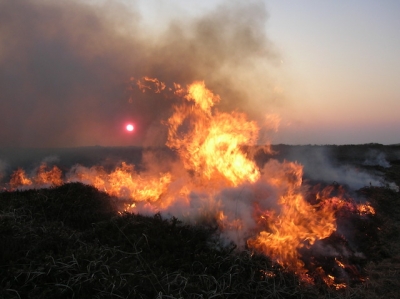 |
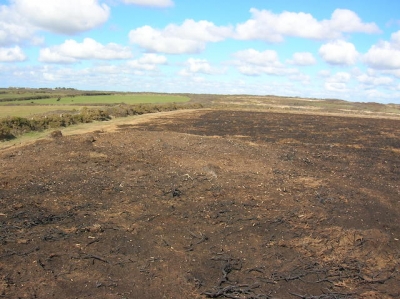 |
| The flames flare and begin to die | The aftermath, waiting for life to begin anew |
I sometimes consider our ancient hunter gather ancestors who would have used similar methods both here and around the world, not to improve conditions for flowering plants, but rather to create an area of improved grazing that would draw in greater numbers of the animals that they wished to hunt. Though some people like to use natural firebreaks to stop the passage of the flames, we here on the NNR prefer the greater certainty that comes from taking a tractor and mower to a controlled burn as it allows greater ease to create new firebreaks and to extinguish a dying fire front. So this Spring if you encounter an area that has been recently burned do not bemoan its present state, rather consider the method and return in a couple of years to enjoy the great diversity of life that has sprung from the scorched earth.
Published: April 2016
Author: Duncan Lyne (Lizard National Nature Reserve Warden)
